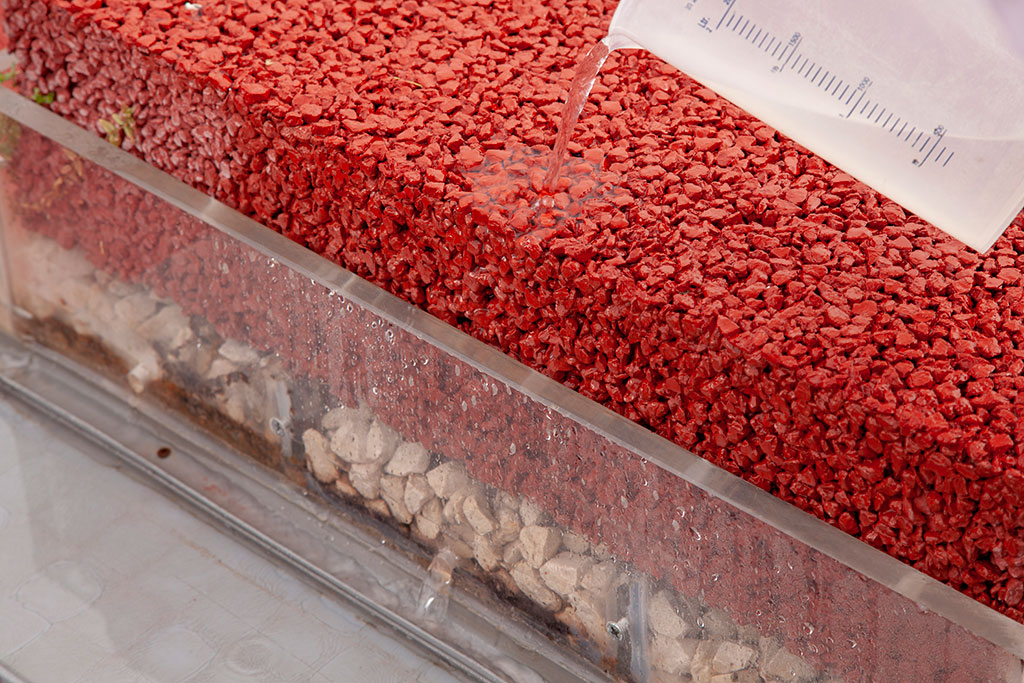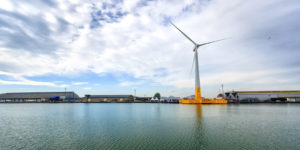Urban development and climate change are leading to a growing threat of surface water flooding. New concrete technologies could offer an innovative solution to this global problem.
Surface water flooding in urban areas, also known as pluvial flooding, is becoming a major issue across the world. As urban development increases, so do larger areas of impermeable surfaces such as roads and pavements, which cannot absorb rainfall as effectively as bare ground.
Now, with climate change causing greater intensity and frequency of heavy rainfall worldwide, instances of urban flooding are becoming more common and more destructive. It is therefore crucial to address the root causes of surface water flooding in order to protect the world’s populations from potential natural disasters.
Tackling urban flooding
Urban flooding is usually the result of high intensity rainfall on tarmacked or paved surfaces. Excess rainfall not absorbed by the roads and pavements gathers, quickly filling up drains and sewerage systems and causing everything from hydroplaning to more serious flooding.
Associate director of civil engineering Jeff Colson, warns that, “Urban flooding today is a common occurrence in the urban environment, which is causing lots of damage. Climate change is causing more severe storm events, higher intensity, more rainfall.
“This is in combination with increased development in urban environments generating a more concentrated area where people live. With more hard standings, more impermeable areas, and more higher rainfall events, flooding is only going to get worse.”
“With more hard standings, more impermeable areas, and more higher rainfall events, flooding is only going to get worse” - Jeff Colson, Associate director of civil engineering
One solution is to tackle the cause of urban flooding from the ground up – by replacing waterproof, non-porous urban surfaces, such as asphalt and tarmac, with porous concrete. Porous concrete is designed to allow water to pass through it, meaning water cannot gather on its surface and lead to flooding or icy surfaces in cold weather.
Italian cement manufacturer Calcestruzzi understands that the increasing effects of climate change means public administrators and urban planners are having to consider large-scale solutions to urban flooding.
Enrico Corio, Innovative Products Manager at Calcestruzzi, says: “Over the last few decades, we have been experiencing the negative effects of climate change in our cities. Higher temperatures have caused much heavier rainfall over shorter periods – a weather phenomenon we call ‘water bombs’, because of huge amount of water that falls in one area in a very short time.
Porous concrete is designed to allow water to pass through it, meaning water cannot gather on its surface and lead to flooding or icy surfaces in cold weather
“Most urban areas today will have waterproof roads and pavements, which are designed to funnel rain water into sewer networks. Of course, these were designed before the ‘water bomb’ phenomenon became more common. This means the current sewer networks are undersized for the amount of water today and will often overflow into the streets.”
Aside from causing potentially billions worth of property and infrastructure damage, traffic congestion and problems with public transport, urban flooding can cause further problems which are dangerous and disruptive for people who live in urban areas.

Constructing urban infrastructure like cycle paths from porous concrete can have significant benefits
Benefits of porous concrete
In face of the growing problem of urban flooding, Calcestruzzi developed i.idro DRAIN, a porous concrete product with an exceptionally high drainage capacity. “In terms of draining performance, i.idro DRAIN is designed to drain a huge of quantity of water – from 200l per m2 per minute to over 1000l per m2 per minute. This means the water drains away almost instantly, preventing any surface build up,” says Enrico.
However, the major way i.idro DRAIN differs from other porous concrete is the way it works with the local area. “When rain falls, water goes through the i.idro DRAIN surface very quickly and down in the ground,” says Enrico. “However, we can install one of two options according to the permeability of the ground itself. In the case of good ground permeability, the water goes directly into the soil.
“i.idro DRAIN is a concrete composite so therefore has higher durability than asphalt. This reduces the maintenance costs usually associated with concrete flooring” - Enrico Corio, Calcestruzzi,
“When the ground permeability isn’t as good, we install a semi-porous layer under the i.idro DRAIN, which creates a sort of holding tank for the water as it slowly drains away. In the worst cases, we can also install pipes that allow the excess water to flow into the sewer network. This means the system can be designed to fit with different ground conditions.”
Calcestruzzi are not the only cement company exploring new solutions to the problem of urban flooding. In Lyon, France, LafargeHolcim operate a state-of-the-art R&D centre that looks to develop innovative products, solutions, and services, as well as advanced manufacturing processes.
LafargeHolcim’s Country Technical Support Engineer Nicolas Pouteau works at the Lyon centre, which has been developing the company’s own version of porous concrete.
“Porous concrete can be used for many applications,” says Pouteau. “It can be used for car parks. We need to have space for a lot of vehicles so this can create a huge surface of impervious materials and in France we are building more and more bicycle pathways.”
“The long-term benefits of porous concrete, in terms of the cost for urban areas, is to reduce the chance of a flooding event, as we are able to store water inside the concrete. It allows us to reduce the drainage system, so this is a very good product for this kind of application.”

Porous concrete can be used for a variety of applications
A sustainable solution
Aside from its drainage abilities, i.idro DRAIN differs from more traditional urban surface materials – such as asphalt and tarmac – in a number of beneficial ways. “i.idro DRAIN is a concrete composite so therefore has higher durability than asphalt,” explains Enrico. “This reduces the maintenance costs usually associated with concrete flooring.”
i.idro DRAIN is also made of aggregate cement, which uses raw materials taken from the local environment. This means the concrete can be recycled, as well as containing no oils or other polluting agents, which could flow into nearby rivers or seas.
“The long-term benefits of porous concrete, in terms of the cost for urban areas, is to reduce the chance of a flooding event” - Nicolas Pouteau, LafargeHolcim
Using locally sourced base materials also matters from an aesthetic point of view, in addition to helping cities achieve environmental standards or certification. “Designers and architects very often highlight the need to have pavements and surfaces that are aesthetically consistent with the natural surrounding environment,” says Enrico. “With this product, urban designers have a variety of colours to choose from so they can match the concrete to the colour of the cities, roads or buildings in the area.”
Finally, i.idro DRAIN has the added ability to reduce surface temperatures as it has solar reflective properties (high refractive index), thus reducing the temperature of cities – yet another growing problem caused by climate change.
Solidifying the future
As the planet and its cities face more challenges due to the effects of climate change, urban developers will have to look more and more to affordable and sustainable responses to tackle natural disasters.
Porous concrete is an ideal solution for eliminating urban flooding on low capacity roads, cycle lanes and pedestrian zones, as well as public spaces and car parks, and can help solidify a future of sustainable urbanisation.




